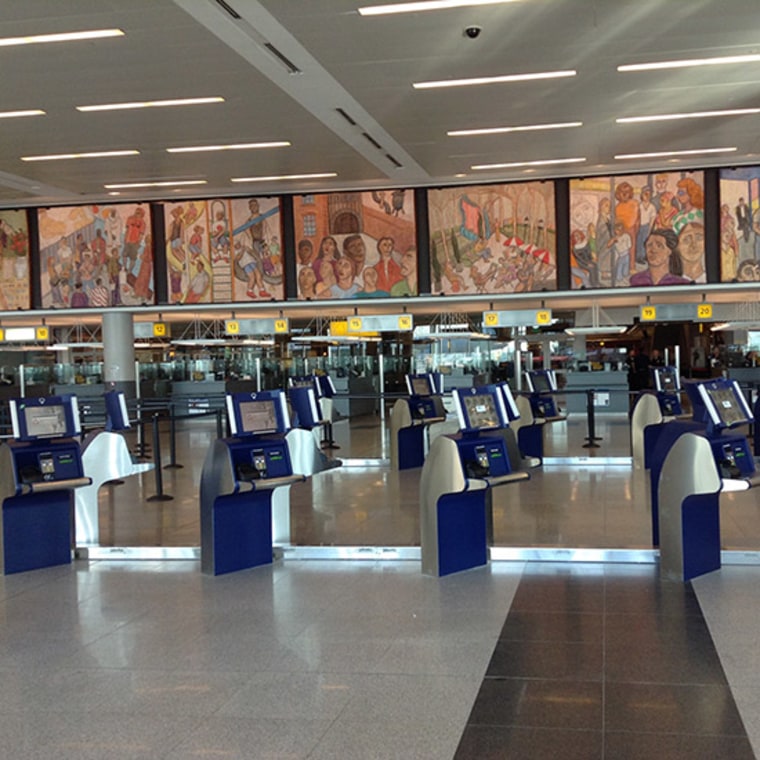JFK International is getting automated passport machines on Monday to speed up the arrival of U.S. passengers from international flights. It's the latest airport—and one of the largest—to get the system.
Similar self-service machines already in use at Chicago's O'Hare International Airport Terminal 5, and at two airports in Canada (Vancouver and Montreal) are already helping to significantly cut down wait times at customs that, at times, have forced arriving international passengers to stand in line for up to five hours or to be held back on a plane.
JFK is the busiest U.S. entry point for international travelers, and 40 automated passport kiosks have been purchased by Delta for use in Terminal 4, where it is the largest tenant among more than 30 airlines. At JFK, only U.S. citizens will initially be able to use the machines, but soon Canadian citizens should be able to use the machines as well.
"We're going to have a couple hundred people—100 today, 200 tomorrow—test the system. If all goes well, we'll go fully live on Wednesday," Delta spokeswoman Leslie Scott said Monday.
(Read more: Airport dining upgraded with high-profile names)
Several vendors, including the Vancouver Airport Authority and SITA, make and market the technology and the hardware, so the cost of an individual kiosk is confidential, but Delta says its overall cost is somewhere between $50,000 and $100,000 per kiosk.
Delta would like the Custom and Border Protection agency to increase staffing and improve scheduling to accommodate peak arrival times. "But we don't know how long that will take," Scott said. "This is something proactive we can do now as an investment in the customer experience. Because if a passenger has enjoyed the in-flight meals, the lie-flat bed and other aspects of an international flight having to stand on line for hours on arrival really ruins the experience."
(Read more: Where to find airport Wi-Fi for free or for a fee)
According to the Chicago Department of Aviation, since July 1, when the automated passport control technology was rolled out at O'Hare Airport's Terminal 5, daily passenger volume has increased by 21 percent, to over 15,000, but wait times during peak arrival periods have been reduced by 33 percent.
The number of passengers waiting over 60 minutes per day at O'Hare has been reduced by nearly 60 percent, and the number of passengers waiting for over two hours has been eliminated almost entirely. The number of passengers missing their connected flights has been drastically reduced as well.
At O'Hare, only U.S. citizens could initially use the kiosks, but this month the program was expanded to include Canadian citizens as well.
(Read more: 'TSA feel-ups': What you miss during the shutdown)
Several other airports around the country are also getting to roll out automated passport control machines.
Machines made by SITA at Orlando International "are deployed but not yet in use," said SITA's Sean Farrell. "We're just waiting for U.S. Customs and Border Protection to certify the system, but right now that agency is on furlough."
Houston's Bush Intercontinental Airport has 20 kiosks that should be operational by the end of the year.
Dallas/Fort Worth International is planning to have 30 machines it purchased from the Vancouver Airport Authority at a cost of about $2 million up and running by early November.
And 36 automated passport machines, purchased at a cost of $3.5 million by the Miami-Dade Aviation Department, will be installed in November at Miami International.
"It's pretty well documented that we've had challenges in our international arrivals area," said Miami's airport spokesman Greg Chin. "Our peak waiting times have been as much as two to three hours, and this is one of the ways we're trying to mitigate the challenges. Visitor makeup is 70 percent U.S. citizens at O'Hare versus 70 percent non-U.S. visitors at MIA, and because U.S. citizens are easier to process, we don't think our reduction will match [O'Hare's] 30 percent but we hope to at least approach that."
—By Harriet Baskas, Special to CNBC. She is the author of seven books, including "Hidden Treasures: What Museums Can't or Won't Show You," and the Stuck at the Airport blog. Follow her on Twitter at @hbaskas.
